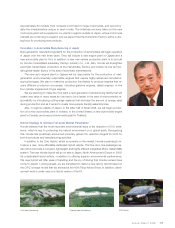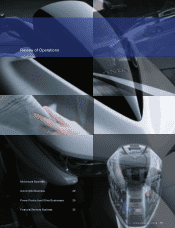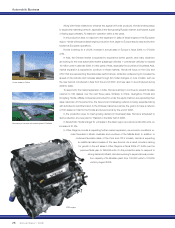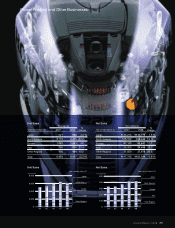Honda 2008 Annual Report Download - page 25
Download and view the complete annual report
Please find page 25 of the 2008 Honda annual report below. You can navigate through the pages in the report by either clicking on the pages listed below, or by using the keyword search tool below to find specific information within the annual report.
Review of Operations
Honda’s unit sales of automobiles amounted to 3,925,000 units, up 7.5% from the previous fiscal
year, primarily because of increased sales in North America, Europe, Asia and Other Regions.
Revenue rose 6.8% from the previous fiscal year, to ¥9,489.3 billion, reflecting the rise in the
number of units sold and the positive impact of currency translation effects.
Operating income posted a gain of 10.4%, to ¥661.6 billion. This was due mainly to the posi-
tive effects of higher revenue, cost reductions, price increases and currency effects. These positive
factors offset such negative developments as higher sales incentives in North America, the sharp
rise in raw material costs, higher SG&A expenses, changes in the model mix as well as increases
in R&D costs and depreciation.
Total automobile demand in Japan* (as measured by the number of registrations of regular ve-
hicles (661cc or higher) and mini-vehicles (660cc or lower)) through December 2007 was below
the level of the previous year for 21 consecutive months, thus creating severe market conditions.
In fiscal 2008, total demand declined from the previous fiscal year, to approximately 5,320,000
units. Of this total, regular vehicle registrations remained below the level of the previous year
throughout the fiscal year and amounted to approximately 3,430,000 units, despite the positive
impact on sales of the Tokyo Motor Show in the latter half of fiscal 2008 and the introduction of
new models by various automakers. Registrations of mini-vehicles amounted to about 1,890,000
units, also below the level of the previous fiscal year. This was partly because of a decline of the
positive impact of the introduction of new types of mini-vehicles, in spite of the continued interest
among drivers in owning these vehicles.
Amid this operating environment, Honda’s unit sales in Japan during fiscal 2008 declined
8.5%, to 615,000 units. This was partly due to the decline in the sales of the Zest and Life in
the mini-vehicle category, despite strong sales in the regular vehicle category where sales of the
Stream and CR-V continued to be strong, and sales of the new models such as the Fit and Inspire
were robust.
The second-generation Fit, which was introduced in October 2007, features advances
in packaging, utility, drivability and environmental responsibility. Also, the new Fit was
selected as the Car of the Year Japan 2007-2008 by the Japan Car of the
Year Executive Committee, as the first-generation Fit had previously
achieved. The Fit has been widely acclaimed by a broad range of
customers, and cumulative sales from the time of the intro-
duction of the first-generation Fit through November
2007 have exceeded one million units. In terms
of the number in domestic car registrations,
the Fit placed first in fiscal 2008.
Stream
Fit
* Source: JAMA (Japan Automobile
Manufacturers Association)
Automobile Business
Japan
Annual Report 2008 23
























